Rust Family Foundation: Archaeology Grants Program
States
of Consumption: Cultural Resilience and Politico-Economic Relations at
Jecosh, Callejon de Huaylas, Peru (1-1000 CE)
Principal Investigator: Marie Elizabeth Grávalos
Department of Anthropology, University of Illinois at Chicago
The significance of this project is three-fold. First, because few Recuay culture (ca. 100-700 CE) settlements, particularly domestic areas, have been excavated, this research contributes to regional culture history on the Recuay through the lens of household activities at the archaeological site of Jecosh. Second, given the site’s location near several trade routes in the southern end of the Callejón de Huaylas, an intermontane valley in the Department of Ancash, Peru (Fig. 1), this work elucidates our understanding of local participation in new trade networks developed in the Middle Horizon (ca. 700-1000 CE). This diachronic perspective enables an understanding of local Recuay traditions and subsequent cultural changes in the Middle Horizon, a period of heightened interregional interaction across the prehispanic Andes.
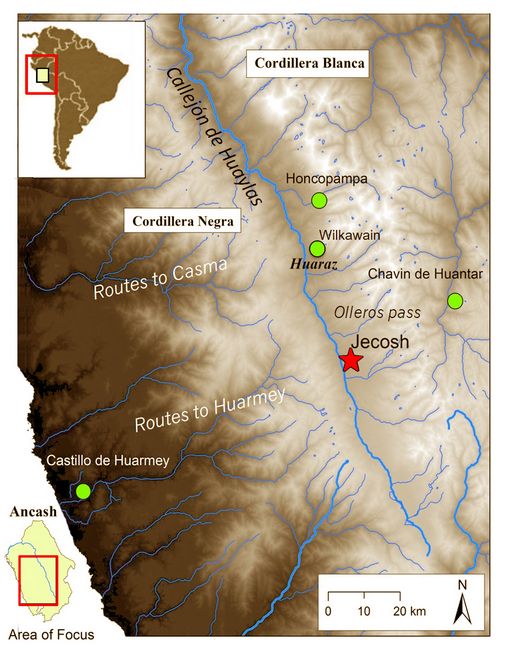
Finally, Jecosh is a well-known but little studied site that has fascinated nearby farming communities, local school students, and researchers alike due its well-preserved surface architecture. Research at Jecosh has been a collaborative effort with the nearby community of Pocrac, which trained participants in excavation techniques and demonstrated the importance of active efforts to preserve cultural patrimony for future study and economic development.
Fig.1: Detail of Callejón de Huaylas valley within the Department of Ancash, Peru, showing the archaeological site of Jecosh and nearby regional centers.
Previous research at the site:
The 2017 work represented the first systematic excavation project at Jecosh.
Previous site survey and mapping, however, enabled this current project to come to fruition.The site was originally documented by Peruvian archaeologist Julio C. Tello, who showed the site to Wendell C. Bennett, a researcher from the American Museum of Natural History who conducted excavations in highland Ancash in 1938 (Bennett 1944; Tello 1929). In 1977 North American archaeologist Steven Wegner surveyed Jecosh and collected ceramic sherds from the site surface, many of which were made of white kaolin clay, a typical Recuay pottery attribute (Wegner 2004, personal comm. 2015). More recently, local Huaraz archaeologist Denisse Herrera Rondan (2016) documented the site, including a full site survey, architectural analysis and drawing, analysis of surface artifacts, and topographic work.
Results of Funded Project (RFF-2017-43):
In collaboration with Herrera Rondan, the Proyecto de Investigación Arqueológico Jecosh (PIAJ) was created by Marie Elizabeth Grávalos and Emily A. Sharp in 2017 to refine the site map and conduct excavations. These three personnel directed field excavations at Jecosh and lab work in the city of Huaraz. We hosted three Peruvian and two North American undergraduate students as well as two graduate student volunteers during excavations. Three additional student volunteers worked with us in the lab in Huaraz. In addition to volunteers, we paid community laborers to help with excavations, with whom we worked closely and trained in excavation techniques. Despite having a relatively small team, we were able to conduct 245 sq. meters of excavations in mortuary and domestic spaces in 2017. The Rust Family Foundation funded excavations of domestic areas, which were directed by the grantee, Marie Elizabeth Grávalos.
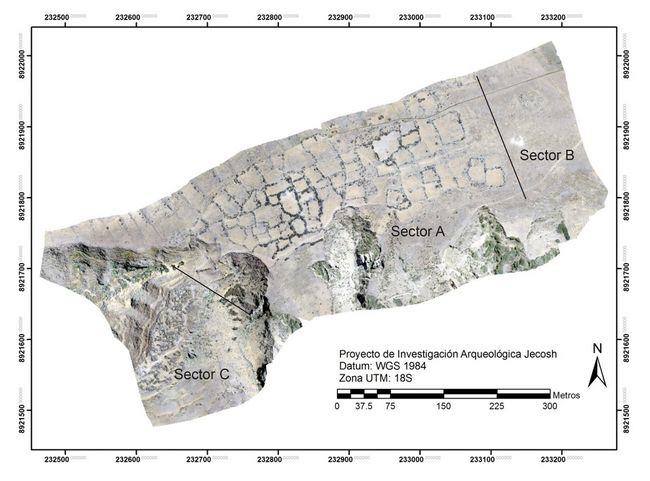
Fig.2: Drone map of Jecosh site showing original sectorization by Herrera Rondan (2016). (Image created by Emily A. Sharp.)
Project goals:
The PIAJ team had three primary goals during the 2017 field season:
1. Create a topographic map of the site of Jecosh, including superficial architecture of domestic, mortuary, and public spaces (Fig 2.).
a. This was fulfilled through the use of a total station as well as a contracted photogrammetry specialist.
2. Conduct vertical test excavations in domestic and mortuary areas and expand operations horizontally where appropriate.
a. Grávalos and Sharp directed two teams of paid laborers and student volunteers in the domestic and mortuary areas over a 12-week period.
3. Carry out preliminary lab work of excavated materials, including cleaning, cataloging, and analysis of various artifact classes.
a. Excavated materials were moved to Huaraz (approved by the Ministry of Culture) for lab work. The PIAJ team worked quickly to clean and catalogue everything during this brief lab period.
Methodologies and findings:
First, we undertook preliminary site mapping and survey using a Nikon NPL-352 total station to refine Herrera Rondan’s (2016) original map. Based on this topographic work, we selected 10 domestic areas for excavations in Sectors A and B. Excavations of domestic areas were aimed at revealing horizontal activity patterns as well as vertical construction chronology. The PIAJ team excavated according to natural and cultural levels, assigned a unique context number to each cultural/natural layer, arbitrary level, and specialized feature (e.g. ash lens, architectural division).
For vertical control, no context is deeper than 10cm and, for horizontal, operations were sub-divided into 1x1m sub-operations. PIAJ excavators separated and bagged recovered artifacts by material type and according to their corresponding context number and horizontal sub-operation (e.g. all ceramics from context 101, sub-op. A1). For every undisturbed context, the PIAJ team took 5-liter soil samples for flotation to recover macro-botanicals and 200-ml soil samples to conduct micro-botanical analyses (e.g. phytolith and starch grain).
PIAJ team members also carried out architectural analysis of excavated structures, documenting construction techniques (masonry style, rock/mortar type) and measurements/orientations of walls, rooms, doors, and niches. At the end of the field season, PIAJ contracted a photogrammetry specialist to further document the site’s topography with an aerial drone, which enabled us to create 3D images using ESRI’s ArcGIS software (Fig. 3).
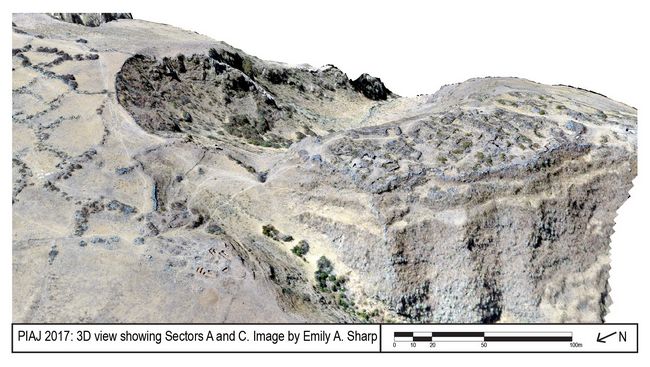
Fig.3: 3D image created with aerial drone data.
Following fieldwork, PIAJ team members cleaned and catalogued all recovered artifacts during an initial lab season. Grávalos undertook fine-grained ceramic analysis, collecting data on vessel shape,
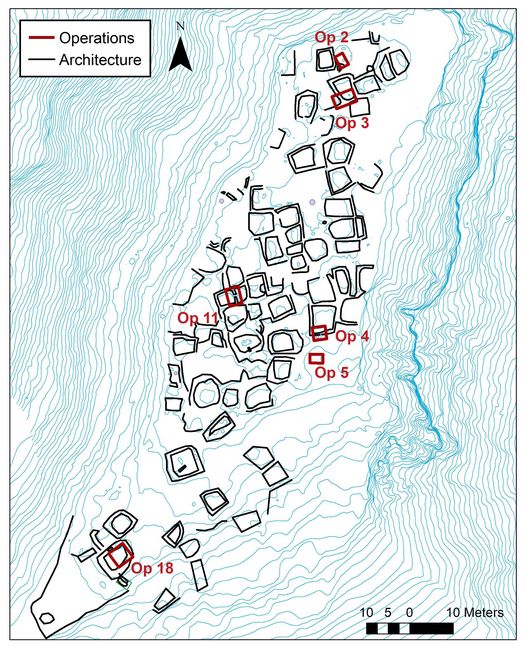 size, and thickness,
rim forms, surface treatments, decoration, firing attributes, and
interior/exterior carbonization (Rice 1987; Roddick 2009; Skibo 2013).
This also included digital microscopic paste analysis to understand
variable potting recipes (Druc 2015). This work, conducted on a sample
of 1,307 ceramic sherds, revealed that more than 30 discrete paste
types were used in domestic settings at Jecosh. Ceramic attribute data
synthesis and statistical analysis is currently ongoing, and more
ceramic attribute analysis to increase sample size is planned for 2018.
size, and thickness,
rim forms, surface treatments, decoration, firing attributes, and
interior/exterior carbonization (Rice 1987; Roddick 2009; Skibo 2013).
This also included digital microscopic paste analysis to understand
variable potting recipes (Druc 2015). This work, conducted on a sample
of 1,307 ceramic sherds, revealed that more than 30 discrete paste
types were used in domestic settings at Jecosh. Ceramic attribute data
synthesis and statistical analysis is currently ongoing, and more
ceramic attribute analysis to increase sample size is planned for 2018.Fig.4: Sector C map showing excavated operations of domestic spaces.
PIAJ’s excavations of domestic areas yielded several interesting findings. The PIAJ team excavated 103 sq. meters in domestic spaces in Sectors A and C. Unfortunately, due to differential site preservation between these areas, Sector A yielded highly disturbed and shallow strata with few material remains (4/10 excavated operations). The team did recover some diagnostic pottery, which based on design motifs, can be affiliated with the Late Intermediate Period (ca. 1000-1450CE) Aquilpo style. Fortunately, excavations in Sector C revealed a wealth of archaeological information (Fig. 4). The results of this work can be broadly divided into two categories: site chronology (Fig. 5) and domestic feasting (Fig. 7)
.
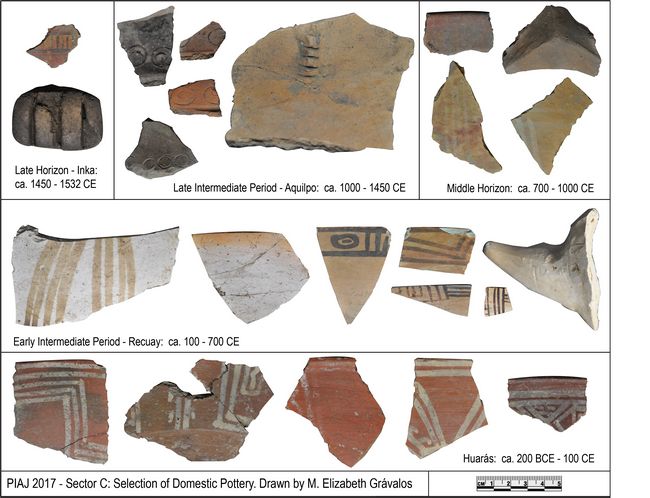
Fig.5: Diagnostic pottery from domestic areas demonstrating Sector C’s long occupational history.
Sector C demonstrates the typical characteristics of a Recuay residential area (Lau 2011:67-76); located in a nat
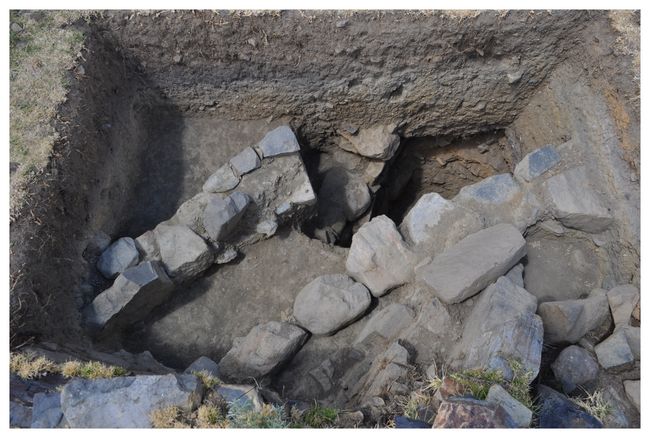 urally isolated area, domestic structures are agglutinated,
often sharing walls, and have open areas/patios for social gathering.
The masonry resembles the “wanka-pachilla”, or block and spall, style
(Tello 1929), and like the Recuay settlements of Chinchawas and Yayno,
some standing walls measure over three meters in height (Fig. 8).
urally isolated area, domestic structures are agglutinated,
often sharing walls, and have open areas/patios for social gathering.
The masonry resembles the “wanka-pachilla”, or block and spall, style
(Tello 1929), and like the Recuay settlements of Chinchawas and Yayno,
some standing walls measure over three meters in height (Fig. 8). Fig.6: Planview photo of Operation 2, showing three distinct construction phases.
Through excavations, PIAJ revealed several significant domestic features and contexts, including primary and secondary refuse from food preparation and consumption. This includes ash lenses and residues/debris on interior residential floor surfaces as well as both single dumping event and accumulated discard middens (inside structures and in open patios). Excavations demonstrated multiple construction phases in residential areas with evidence of secondary refuse inside architectural fills. Most domestic contexts contained faunal evidence including camelid, cervid sp., and rodents as well as a variety of ceramic technologies.
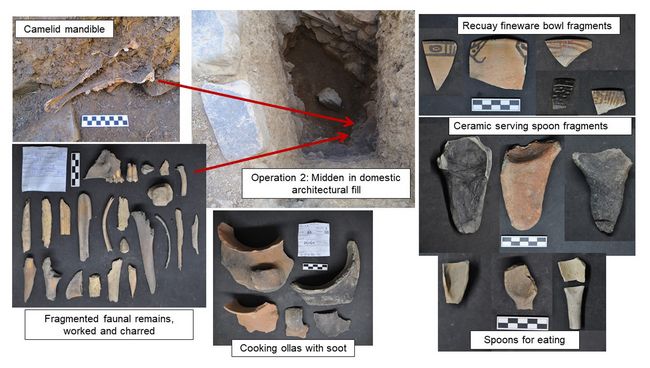
Fig.7: A single event midden found within architectural fill.
Pottery consisted of cooking, servi
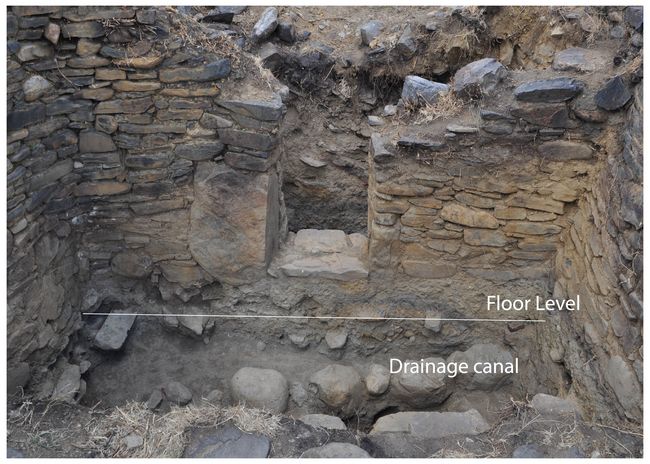 ng, and eating
vessels and implements, such as fineware bowls and plates, large ollas
with soot, and large and small spoons (Fig. 7). These datasets are
congruent with consumption evidence from other Recuay sites in highland
Ancash (e.g. Bria 2017; Lau 2010; Gero 1992).
ng, and eating
vessels and implements, such as fineware bowls and plates, large ollas
with soot, and large and small spoons (Fig. 7). These datasets are
congruent with consumption evidence from other Recuay sites in highland
Ancash (e.g. Bria 2017; Lau 2010; Gero 1992).Fig.8: Operation 11 showing an elite house structure with fine masonry, ash lens residues, and a drainage canal.
Conclusions:
PIAJ’s work has expanded our knowledge of Recuay life through excavation and lab work. Few Recuay sites have been systematically studied, and significantly, Jecosh is the southern most Recuay residential site in the Callejón de Huaylas to be scientifically excavated. Data obtained on the Huarás pottery style (early Recuay) will also yield much needed information about this under studied time period. Evidence from Jecosh provides insight into daily life and feasting at an agglutinated, defensive settlement, contributing to anthropological understandings
of social organization, commensal politics, and everyday practice. .
Ongoing Plans and Final Publication
PIAJ’s primary goal for 2018 is to complete lab work in Huaraz and secure funds for AMS radiocarbon dating as well as specialty compositional analysis (e.g. laser ablation inductively coupled plasma mass spectrometry + petrography) of pottery. To date, we have presented our work at one professional conference (Sharp and Grávalos 2018) and will present more of our findings at the 2018 Society for American Archaeology meeting (Grávalos and Sharp, n.d.).
References
Bennett, Wendell C.
1944 The North Highlands of Peru: Excavations in the Callejón de Huaylas and at Chavín de Huántar. Anthropological Papers of the American Museum of Natural History 39: 1–116.
Bria, Rebecca E.
2017 Ritual, Economy, and the Construction of Community at Ancient Hualcayán (Ancash, Peru). Ph.D. dissertation, Department of Anthropology, Vanderbilt University, Nashville, TN.
Druc, Isabelle C.
2015 Atlas of Ceramic Pastes: Components, Texture, and Technology (with the technical collaboration of Bruce Velde and Lisenia Chavez). Deep University Press, Blue Mounds, WI.
Gero, Joan M
1992 "Feasts and females: Gender ideology and political meals in the Andes." Norwegian Archaeological Review 25(1): 15–30.
Grávalos, Marie Elizabeth and Emily A. Sharp
n.d. "Enduring Traditions, Material Transformations: Understanding Wari State Influence in Highland Ancash, Peru." To be presented at the 83nd Annual Society for American Archaeology Meeting, Washington, D.C. April 11-15th.
Herrera Rondan, Denisse Katherine
2016 Patrón de asentamiento y función del sitio arqueológico de Jecosh, Distrito de Ticapampa, Provincia de Recuay, Departamento de Ancash. Licensure thesis, Department of Archaeology, Universidad Nacional “Santiago Antúnez de Mayolo”, Huaraz, Peru.
Lau, George F.
2011 Andean Expressions: Art and Archaeology of the Recuay Culture. University of Iowa Press, Iowa City.
---2010 Ancient Community and Economy at Chinchawas (Ancash, Peru). Yale University Press, New Haven, CT.
Skibo, James M.
2013 Understanding Pottery Function. Springer, New York.
Roddick, Andrew P.
2009 Communities of Pottery Production and Consumption on the Taraco Peninsula, Bolivia, 200 BC-300 AD. Ph.D. dissertation, Department of Anthropology, University of California, Berkeley.
Rice, Prudence M.
1987 Pottery Analysis: A Sourcebook. University of Chicago Press, Chicago & London.
Sharp, Emily A. and Marie E. Grávalos.
2018 "Dwellings for the living and the dead: Tracing transformations in residential and mortuary architecture at Jecosh, Peru". Unpublished paper presented at the 46th Annual Midwest Conference on Andean and Amazonian Archaeology & Ethnohistory, The Field Museum, Chicago, March 17-18th.
Tello, Julio C.
1929 Antiguo Perú: Primera Época. Comisión Organizadora del Seundo Congreso de Turismo, Lima.
Wegner, Steven A.
2004 "Identificando el área del dominio Recuay: Un extendido inventario cerámico para la indetificación de asentamientos Recuay". In Arqueología de la Sierra de Ancash: Propuestas y Perspectivas, edited by Babel Ibarra Asencios, pp. 121–134. Instituto Cultural RVNA, Lima.
Recent Foundation grants: general Archaeology Grants Program w/map
Copyright © 2018 Rust Family Foundation